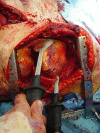Emergency department thoracotomy for the critically injured patient: Objectives, indications, and outcomes
- PMID: 16759407
- PMCID: PMC1459269
- DOI: 10.1186/1749-7922-1-4
Emergency department thoracotomy for the critically injured patient: Objectives, indications, and outcomes
Abstract
In the past three decades there has been a significant clinical shift in the performance of emergency department thoracotomy (EDT), from a nearly obligatory procedure before declaring any trauma patient to select patients undergoing EDT. The value of EDT in resuscitation of the patient in profound shock but not yet dead is unquestionable. Its indiscriminate use, however, renders it a low-yield and high-cost procedure. Overall analysis of the available literature indicates that the success of EDT approximates 35% in the patient arriving in shock with a penetrating cardiac wound, and 15% for all penetrating wounds. Conversely, patient outcome is relatively poor when EDT is done for blunt trauma; 2% survival in patients in shock and less than 1% survival with no vital signs. Patients undergoing CPR upon arrival to the emergency department should be stratified based upon injury and transport time to determine the utility of EDT. The optimal application of EDT requires a thorough understanding of its physiologic objectives, technical maneuvers, and the cardiovascular and metabolic consequences.
Figures





References
-
- Hemreck AS. "The history of cardiopulmonary resuscitation". Am J Surg. 1988;156:430. - PubMed
-
- Beck CS. "Wounds of the heart". Arch Surg. 1926;13:205.
-
- Blatchford JW., III "Ludwig Rehn – The first successful cardiorrhaphy". Ann Thorac Surg. 1985;39:492. - PubMed
-
- Kouwenhoven WB, Jude JR, Knickerbocker GG. "Closed-chest cardiac massage". JAMA. 1960;173:1064. - PubMed
-
- Zoll PM, Linenthal AJ, Norman LR, et al. "Treatment of unexpected cardiac arrest by external electric stimulation of the heart". NEJM. 1956;254:541. - PubMed
Grants and funding
LinkOut - more resources
Full Text Sources
Other Literature Sources
Miscellaneous

